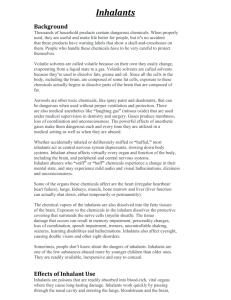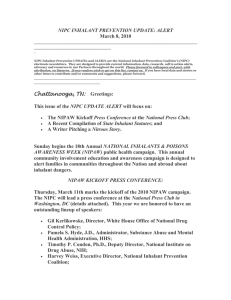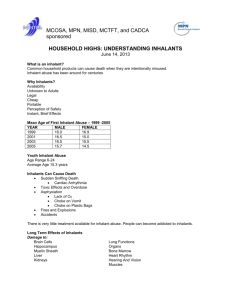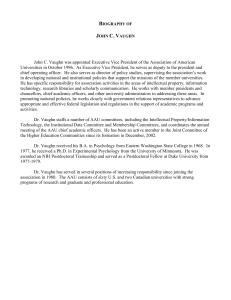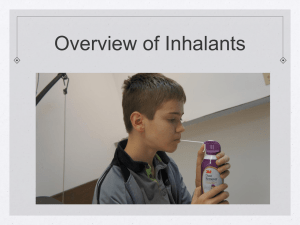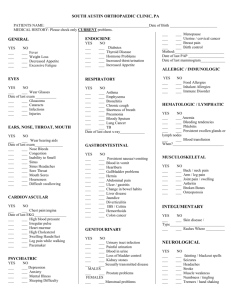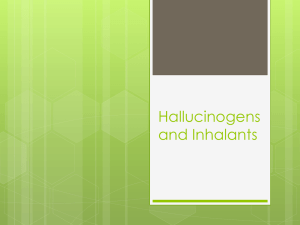Inhalant Use Among Incarcerated Adolescents in the United States
advertisement
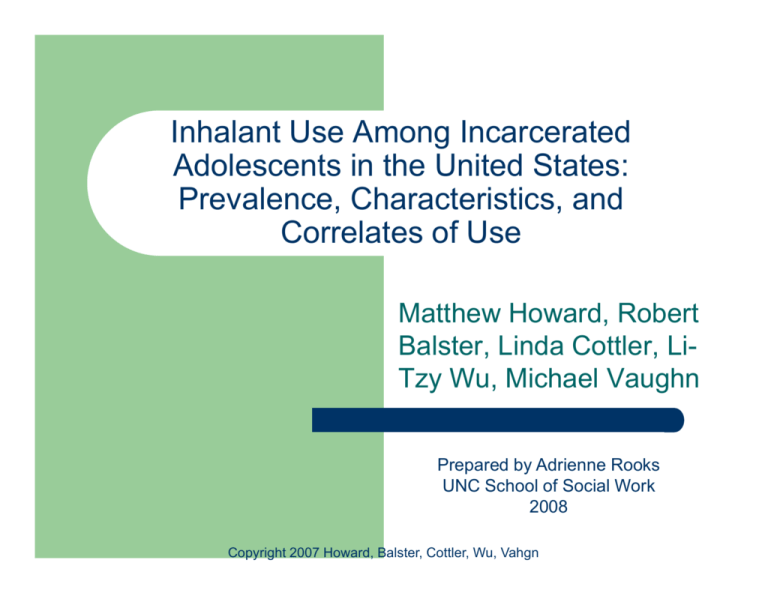
Inhalant Use Among Incarcerated Adolescents in the United States: Prevalence, Characteristics, and Correlates of Use Matthew Howard, Robert Balster, Linda Cottler, LiTzy Wu, Michael Vaughn Prepared by Adrienne Rooks UNC School of Social Work 2008 Copyright 2007 Howard, Balster, Cottler, Wu, Vahgn Introduction z z This presentation is based on a study using residents of 27 Missouri Division of Youth Services Facilities who completed interviews to determine patterns of inhalant use among incarcerated adolescents. Recommendations for future interventions and research are provided Copyright 2007 Howard, Balster, Cottler, Wu, Vahgn Commonly Abused Inhalants in U.S. z z z z z Glue Shoe polish Toluene Lighter fluid Gasoline (Wu et al., 2004) Copyright 2007 Howard, Balster, Cottler, Wu, Vauhgn Inhalants z Methods of Inhaling – – Inhale vapors from a rag soaked with a substance Inhale vapors from a bag where a substance has been deposited Signs of Intoxication – – – – Slurred speech Ataxia Stupor Other signs similar to alcohol intoxication Copyright 2007 Howard, Balster, Cottler, Wu, Vauhgn Clinical Studies on Inhalant Use z Repeated use associated with – – – – – – – – – Parkinson's Cerebellar Ataxia Encephalopathy Trigeminal neuropathy Hepatoxicity Heptorenal syndrome Delayed neurological recovery Deaths due to drug actions and accidents (e.g., Byard et al., 2006; Doring et al., 2002; Finch and Lobo, 2005; Hahn et al., 2006) Copyright 2007 Howard, Balster, Cottler, Wu, Vauhgn Clinical Studies on Inhalant Use Cont. z Neurological findings – – – Cerebral atrophy Thinning of the corpus callosum Lesions of the pyramidal tract/cranial nerve signs (e.g., Yamanouchi et al., 1995) z Single inhalant exposure can cause long-term learning, memory, and attentional impairments (Stollery, 1996) z Inhalant use associated with delinquency, conduct disorder, impulse control, and anxiety disorders (e.g., Kelly et al., 2002; Sakai et al., 2004) Copyright 2007 Howard, Balster, Cottler, Wu, Vauhgn Adolescent Rate of Inhalant Use z Study of 12-17 year olds in US using National Household Survey on Drug Abuse data (Wu et al., 2004) – – – – z 9% of 36,850 respondents reported inhalant use Lifetime rates did not differ by gender or family income American Indian and multiracial youth had higher rates Higher rates among youth from non-metropolitan areas, polydrug users, and those with history of antisocial behavior, foster care placement or mental health treatment Study limitation: excluded incarcerated and institutionalized youth Copyright 2007 Howard, Balster, Cottler, Wu, Vaughn Research on Incarcerated Youth and Inhalant Use z z 18% of youth in a residential/day treatment program for substance abuse and behavior disorders reported inhalant use (Sakai et al., 2004) Inhalant users were significantly more likely to have – – – – – Lifetime history of major depression (23% vs. 12%) Previous suicide attempt (27% vs. 15%) Conduct disorder (93% vs. 81%) Other substance use disorders History of neglect and physical or sexual abuse (Sakai et al., 2004) Copyright 2007 Howard, Balster, Cottler, Wu, Vaughn Research on Incarcerated Youth and Inhalant Use z McGarvey et al (1996) – – – Evaluated 619 youth in a juvenile correctional facility in Virginia 14% of sample used inhalants Limitations: z z z z Unclear how youth were sampled No refusal rate for recruitment reported Inhalant use assessment limited to a few agents Inhalant use assessment included agents with different profiles of effects and patterns of use (Balster, 1998) Copyright 2007 Howard, Balster, Cottler, Wu, Vaughn Limitations of Research on Incarcerated Youth and Inhalant Use z Small sample sizes (e.g., Jacobs and Ghodese, 1988) z Limited assessments of inhalant use and related psychiatric syndromes (e.g., McGarvey et al., 1999) Copyright 2007 Howard, Balster, Cottler, Wu, Vauhgn Current Study Goals 1. 2. 3. 4. Study epidemiology of inhalant use in a state population of incarcerated youth Examine patterns of inhalant use Compare lifetime inhalant users to nonusers Examine factors predicting lifetime inhalant use Copyright 2007 Howard, Balster, Cottler, Wu, Vaughn Study Sample z z z z All current MO Division of Youth Services (DYS) residents eligible DYS: legal guardian of residents 13-17 years assigned by the state’s juvenile courts Representative of incarcerated youth nationally (Sickmund, 2002) 723 youth completed interview (97.7% of DYS residents) Copyright 2007 Howard, Balster, Cottler, Wu, Vaughn Methods z z z Interviews conducted by trained graduate students $10 incentive provided to participants’ facility monetary accounts Interviews conducted confidentially in large rooms with private areas Copyright 2007 Howard, Balster, Cottler, Wu, Vaughn Measures z z Volatile Solvent Screening Inventory (VSSI) 45 minute one-on-one interview to assess: – – – – – – – – Demographic characteristics Medical history Lifetime/annual use of 65 inhalants Other drug use and substance-related problems Current psychiatric symptoms Thoughts of suicide/actual suicide attempts Trauma history Antisocial traits and criminal activity Copyright 2007 Howard, Balster, Cottler, Wu, Vaughn Measures Cont. z Comprehensive Solvent Assessment Interview (CSAI) for those reporting any inhalant use – – – – – – – – – Reasons for starting and stopping Typical modes Locations Contexts and subjective effects Adverse consequences/high-risk behaviors occurring in association with acute inhalant intoxication Perceived risks of inhalant use Estimated likelihood of future inhalant use Sibling or and friend’s use of inhalants DSM-IV Inhalant Abuse and Dependence criteria Copyright 2007 Howard, Balster, Cottler, Wu, Vaughn Data Analysis z Bivariate and adjusted comparisons of lifetime inhalant users and nonusers – – Chi-square and logistic regression for categorical variables t-tests, F-tests, and multiple linear regression for continuous variables Copyright 2007 Howard, Balster, Cottler, Wu, Vaughn Characteristics of Incarcerated Youth Characteristics Participants (n=723) Average age 15.5 (SD=1.2) Male 87% Race African American Caucasian Latino/Latina Bi/Multi-Racial 33% 55.4% 3.9% 7.7% Family receiving public assistance 40.3% Copyright 2007 Howard, Balster, Cottler, Wu, Vahgn Characteristics of Incarcerated Youth Cont. Characteristics Participants (n=723) Prescribed Medication Psychotropic medication ADHD medication Antidepressants Mood stabilizers Antipsychotics 42.3% 37.2% 12.4% 12.4% 10.0% Head injury with extended period of unconsciousness 18.3% Copyright 2007 Howard, Balster, Cottler, Wu, Vahgn Lifetime Inhalant Use Lifetime Inhalant Use Lifetime prevalence Any inhalant 36.9% Number of inhalant products 4 or more inhalants 3 inhalants 2 inhalants 1 inhalants 47.9% 20.2% 16.1% 15.7% Mean number of inhalants used by lifetime inhalant users 4.8 (SD=4.1; median=3.0, range=1.0-24.0) Female inhalant use Male inhalant use 43.6% 35.9% Copyright 2007 Howard, Balster, Cottler, Wu, Vahgn Use of Specific Inhalants Inhalant product Lifetime prevalence Got high Any inhalant 36.9% Gasoline 22.0% 81.8% Permanent markers 14.7% 42.5% Computer duster spray 14.7% 90.6% Spray paint 11.5% 78.3% Nail polish remover 8.7% 47.6% Paint thinner 8.3% 90.0% Air freshener 8.0% 70.7% Correction fluid 7.2% 34.6% Butane 6.9% 58.0% Freon 6.1% 93.2% Copyright 2007 Howard, Balster, Cottler, Wu, Vaughn Inhalants with <6% Lifetime Prevalence z z z z z z z z z z Airplane/model glue Rubber cement Hairspray Other glues/cements Paint remover/stripper Propane Deodorant spray Ether Any other cleaning agent Carburetor cleaner z z z z z z z z z z z Car/exhaust fumes Aerosol glass cleaner Kerosene Lighter fluid Shoe shine/polish Dry erase markers Liquid paint Insecticide spray Paint pens PAM Other inhalants Copyright 2007 Howard, Balster, Cottler, Wu, Vaughn Modes of Use z More than half of all inhalants were sniffed from a container – z Spraying directly into nose or mouth was uncommon – z Computer duster spray and butane Placing plastic bag over nose, mouth, or head was uncommon – z Nail polish, correction fluid, gasoline, and paint pens users Spray paint and Freon Saturated cloth – Plaint thinner, air freshener, hair spray, paint remover/stripper, deodorant spray, ether, and carburetor cleaner Copyright 2007 Howard, Balster, Cottler, Wu, Vaughn Addiction Liability z 100+ lifetime days of use – – – – Butane (14%) Computer duster spray (13.2%) Gasoline (11.9%) Liquid paint (8.4%) Copyright 2007 Howard, Balster, Cottler, Wu, Vaughn Addiction Liability Cont. Less than 5 lifetime days of use z z z z z Gun cleaning solvents (83.3%) Waxes (83.3%) Mothballs (100%) Cooking gases (80%) Any other cleaning agent (77.8%) z z z z z Plaster and gum remover (100%) Insecticide spray (100%) Shoe shine/polish (92.3%) Other glues/cements (75.8%) Balsa wood cement (100%) Copyright 2007 Howard, Balster, Cottler, Wu, Vaughn Recency of Use Inhalant % of lifetime users in year prior to incarceration Any inhalant 87.3% Gasoline 69.2% Computer duster spray 87.6% Permanent markers 76.4% Spray paint 74.7% Nail polish 72.1% Paint thinner 86.7% Nail polish remover 73.0% Air freshener 72.4% Copyright 2007 Howard, Balster, Cottler, Wu, Vaughn Recency of Use Cont. Inhalant % of lifetime users in year prior to incarceration Correction fluid 63.5% Hairspray 78.6% Freon 79.5% Butane 80.0% Airplane/model glue 59.0% Copyright 2007 Howard, Balster, Cottler, Wu, Vaughn Reasons for Starting and Stopping Inhalant Use z Reasons for starting – – – – – Curious about effects (77.2%) Thought it would be fun and exciting (70.4%) Felt bored (63.3%) Easier to get than other drugs (61.8%) Fun to use (51.0%) z Reasons for stopping – – – Got tired of them (56.6%) Felt need to change (56.2%) Did not like them (48.4%) Copyright 2007 Howard, Balster, Cottler, Wu, Vaughn Preferred Locations of Use Location Prevalence Home Friend’s home Parties 35.2% 28.5% 15.4% “On the street” 12.0% “Other” places 4.9% School grounds 4.1% Copyright 2007 Howard, Balster, Cottler, Wu, Vaughn Temporal Patterns of Use Temporal Pattern of Use Prevalence Weekends 39.7% Evenings 35.2% Immediately after school 10.9% During school hours 10.1% Mornings before school 4.1% Copyright 2007 Howard, Balster, Cottler, Wu, Vaughn Contexts of Use z z z z z z z z Thought about how good a rush or high had felt (51.3%) Met with some friends and wanted to have good time (43.4%) With a group of people using inhalants (43.0%) With friends and wanted to increase their enjoyment (42.7%) Felt happy (37.4%) With other people and felt they were expected to join in (35.7%) Found inhalant or saw something that reminded them (35.2%) When felt overwhelmed and wanted to escape (34.1%) Copyright 2007 Howard, Balster, Cottler, Wu, Vaughn Perceived Risks z Using inhalants on 1 or 2 occasions – – – – z Great risk (38.6%) Moderate risk (23.6%) Slight risk (27.0%) No risk (10.9%) Regular inhalant use – – – – Great risk (70.4%) Moderate (18.0%) Slight (6.7%) No risk (4.9%) Copyright 2007 Howard, Balster, Cottler, Wu, Vaughn Perceived Problems with Inhalants z Perceived Problems – – – – z Never experienced problems (56.9%) Small problems (21.0%) Moderate problems (14.6%) Big problems (7.5%) Perceived Availability – – Widely available (81.3%) Very or fairly easy to get (12.0%) Copyright 2007 Howard, Balster, Cottler, Wu, Vaughn Perceived Likelihood of Future Inhalant use Perceived Likelihood of Future Use Percent of Respondents “No Chance” 72.3% Little chance 16.9% Even chance 7.5% Good chance 2.6% Certain they would use 0.7% Copyright 2007 Howard, Balster, Cottler, Wu, Vaughn Peer and Sibling Inhalant Use Peer and Sibling Use Prevalence Peer Use All of friends Most of friends Some of friends A few friends 3.4% 14.6% 18.9% 36.3% Sibling who used inhalants 20% Copyright 2007 Howard, Balster, Cottler, Wu, Vaughn Unadjusted Univariate Contrasts of Lifetime Inhalant Users and Nonusers Across Criminological Measures Criminological Variables Ma (SD) Lifetime inhalant Users Nonusers Results SRD (Total Delinquency) 27.8 (19.1) 22.4 (17.8) t(721)=-3.9, p<.001, d= -.29b SRD (Property Crime Index) 16.9 (12.2) 12.3 (11.3) t(721)=-5.1, <.001, d= -3.8 Age at onset of offending (years) 10.1 (2.8) 10.8 (2.9) t(719)=3.2,p<.01, d=.24 aM=Mean; SD = standard deviation; bd=Cohen’s effect size for two independent groups computed using ttest values and associated degrees of freedom Copyright 2007 Howard, Balster, Cottler, Wu, Vaughn Unadjusted Univariate Contrasts of Lifetime Inhalant Users and Nonusers Across Health Measures Cont. Physical and mental health N(%) Lifetime inhalant Users Nonusers Results History of head injury 64 (24.0%) 68 (15.0%) X2(1)=9.0, p<.01, ORa=1.8, (1.2-2.6) Diagnosis W/mental illness 176 (66.2%) 194 (42.7%) X2(1)=36.9, p<.001, OR=2.6, (1.9-3.6) Hearing voices 58 (21.7%) 48 (10.5%) X2(1)=16.9, p<.001, OR=2.4 (1.6-3.6) aOR=unadjusted odds ratio with 95% confidence interval Copyright 2007 Howard, Balster, Cottler, Wu, Vaughn Unadjusted Univariate Contrasts of Lifetime Inhalant Users and Nonusers Across Mental Health Measures Brief Symptom Inventory M (SD) Lifetime Nonusers inhalant Users Global Severity Index 54.6 (37.5) 37.4 (31.5) t(482.9)a =− 6.3,p< .001, d =−.57 Somatization 4.5(4.7) 3.1(4.0) t(490.6) =− 4.3,p< .001, d = .−39 ObsessiveCompulsive 8.4(5.8) 5.5(4.8) t(480.5) =−6.9,p< .001, d =−.63 Interpersonal Sensitivity 3.6(3.7) 2.5(3.1) t(485.6) =−4.0,p< .001, d =−.36 Depression 6.2(5.6) 3.9(4.5) t(460.4) =−5.7,p< .001, d =−.53 aStatistical Results contrasts associated with fractional degrees of freedom represent cases where violations of homogeneity of variance assumptions necessitated more stringent tests for statistical significance Howard et al. Unadjusted Univariate Contrasts of Lifetime Inhalant Users and Nonusers Across Mental Health Measures Cont. Brief Symptom Inventory M (SD) Lifetime Nonusers inhalant Users Results Anxiety 5.9 (5.3) 3.5(4.1) t (459.8) =−6.4, p < .001, d =−.60 Hostility 7.0(5.1) 5.5(4.8) t (721) =−4.0, p < .001, d =−.30 Phobic Anxiety 2.5(3.4) 1.7(3.0) t (508.3) =−3.1, p < .01, d =−.27 Paranoid Ideation 7.2(4.7) 5.7(4.6) t (721) =−4.2, p < .001, d =−.31 Psychoticism 3.0(3.3) t (445.3) =−5.5, p < .001, d =−.52 4.7(4.4) Copyright 2007 Howard, Balster, Cottler, Wu, Vaughn Unadjusted Univariate Contrasts of Lifetime Inhalant Users and Nonusers Across Mental Health Measures Cont. Psychopathic Personality Inventory M (SD) Lifetime Nonusers inhalant Users Results Total 141.5(15.1) 133.4(12.5) t (478.7) =−7.4, p < .001, d =−.68 Machiavellian Egocentricity 7.9(4.4) 16.9(4.5) t (721) =−3.0, p < .01, d =−.22 Carefree Nonplanfulness 15.4(3.8) 13.5(3.8) t (721) =−6.6, p < .001, d =−.49 Fearlessness 19.4(4.9) 15.7(5.0) t (721) =−9.7, p < .01, d =−.72 Copyright 2007 Howard, Balster, Cottler, Wu, Vaughn Unadjusted Univariate Contrasts of Lifetime Inhalant Users and Nonusers Across Mental Health Measures Cont. Psychopathic Personality Inventory M (SD) Lifetime Nonusers inhalant Users Results Blame Externalization 18.9(4.7) 17.9(4.8) t (721) =−2.8, p < .01, d =−.21 Impulsive Nonconformity 16.1(4.5) 14.0(3.7) t (472.6) =−6.3, p < .001, d =−.58 Stress Immunity 18.3(4.4) 19.4(4.3) t (721) = 3.3, p = .001, d = .25 Copyright 2007 Howard, Balster, Cottler, Wu, Vaughn Unadjusted Univariate Contrasts of Lifetime Inhalant Users and Nonusers Across Attitudinal Measures Cont. Lifetime Nonusers Antisocial inhalant Users Process Screening Device M (SD) Results Total 17.7 (5.4) 15.4(5.4) t (720) =−5.5, p < .001, d =−.41 C/U Traits 8.3(3.3) 7.3(3.0) t (720) =−3.9, p < .001, d =−.29 Impulsivity 7.2(2.0) 6.1(2.1) t (720) =−7.3, p < .001, d =−.54 Copyright 2007 Howard, Balster, Cottler, Wu, Vaughn Unadjusted Univariate Contrasts of Lifetime Inhalant Users and Nonusers Across Attitudinal Measures Cont. MA Youth Screening Inventory M (SD) Lifetime Nonusers inhalant Users Results Traumatic Experiences 2.6(1.4) 2.3(1.4) t (715) =−3.34, p < .001, d =−.25 MAYSI-Suicide Ideation 2.9(2.1) 1.4(1.8 t (508.9) =−9.9, p < .001, d =−.88 Copyright 2007 Howard, Balster, Cottler, Wu, Vaughn Unadjusted Univariate Contrasts of Lifetime Inhalant Users and Nonusers Across Substance Use Measures Substance use and related problems Lifetime inhalant Users Nonusers Results MAYSI-Alcohol/Drug 5.1(2.9) Problems Scale M (SD) 3.2(2.3) t (626.1) =−11.6, p < .001 d =−.93 Lifetime # of drug types used M (SD) 5.9(2.9) 2.9(2.1) t (432.4) =−15.0, p < .001 d =−1.44 Lifetime alcohol use N (%) 254(95.1%) 359(78.7%) χ2 (1) = 35.1, p < .001, OR= 5.3 (2.9– 9.6) Copyright 2007 Howard, Balster, Cottler, Wu, Vaughn Unadjusted Univariate Contrasts of Lifetime Inhalant Users and Nonusers Across Substance Use Measures Cont. Substance use and related problems Nonusers Results Age at onset of 11.1(2.8) alcohol use (years) M (SD) 12.0(2.6) t (611.1) = 3.8, p < .001, d = .31 Lifetime marijuana use N (%) 255(95.5%) 371(81.4%) χ2 (1) = 29.0, p < .001, OR= 4.9 (2.6–9.1) Age at onset of marijuana use (years) M (SD)a 11.0(2.4) 11.5(2.1) aLifetime Lifetime inhalant Users t (623.2) = 3.1, p < .01, d = .25 inhalant users had significantly higher rates of kidney disease and hormonal disorders, and an earlier mean age at onset of contact with police Copyright 2007 Howard, Balster, Cottler, Wu, Vaughn Multiple Logistic Regression Examining Race of Lifetime Inhalant Use in Total Sample of Inhalant Users and Nonusers Race b S.E. Wald p Odds Ratio 95.0% CI(OR) African American 22.2 1.0 Caucasian 1.2 .35 12.6 <.001 3.4 (1.7-6.7) Latino/Latina 2.4 .57 18.0 <.001 11.2 (3.7-34.1) Bi/Multiracial .94 .46 4.2 <.05 2.6 (1.0-6.3) Copyright 2007 Howard, Balster, Cottler, Wu, Vaughn Multiple Logistic Regression Examining Geographic Area of Residence of Lifetime Inhalant Use in Total Sample of Inhalant Users and Nonusers Geographic Area of Residence Variable b S.E. Wald Urban p 15.9 1.0 Odds 95.0% Ratio CI(OR) Suburban -.46 .36 1.7 .20 .63 (.31-1.3) Small town .70 .27 6.8 <.01 2.0 (1.2-3.4) Rural -.01 .42 .00 .99 .99 (.43-2.3) Gender -.43 .33 1.7 .19 .65 (.34-1.2) SRD-Property Crime Index .01 .01 1.1 .29 1.0 (.99-1.0)a Age at Onset of Offending .01 .04 .08 .78 1.0 (.94-1.1)a aContinuous variable Copyright 2007 Howard, Balster, Cottler, Wu, Vaughn Multiple Logistic Regression Examining History of Lifetime Inhalant Use in Total Sample of Inhalant Users and Nonusers History b S.E. Wald p Odds 95.0% Ratio CI(OR) Head injury -.11 .29 .15 .70 .90 (.51-1.6) Kidney disease 1.9 1.9 .95 .33 6.4 (.15-262.9) Hormonal disorders 1.4 1.0 2.0 .16 4.2 (.56-30.6) Mental illness .19 .23 .70 .40 1.2 (.77-1.9) BSI-Global Severity Index .00 .00 .56 .45 1.0 (.99-1.0)a aContinuous variable Copyright 2007 Howard, Balster, Cottler, Wu, Vaughn Multiple Logistic Regression Examining PPIa of Lifetime Inhalant Use in Total Sample of Inhalant Users and Nonusers PPI b S.E. Wald p Fearlessness .09 .02 14.0 <.001 1.1 (1.0-1.1)b Carefree Nonplanfulness .05 .03 2.4 .12 1.1 (.99-1.1)b Impulsive Nonconformity .03 .03 1.2 .28 1.0 (.97-1.1)b a Psychopathic Personality Inventory; bContinuous variable Copyright 2007 Howard, Balster, Cottler, Wu, Vaughn Odds 95.0% Ratio CI(OR) Multiple Logistic Regression Examining APSDa of Lifetime Inhalant Use in Total Sample of Inhalant Users and Nonusers APSD b S.E. Wald p Odds 95.0% Ratio CI(OR) Callous/Unemotional .00 .04 .00 .99 1.0 (.92-1.1)b Impulsivity .08 .07 1.4 .24 .92 (.81-1.1)b MAYSIb Suicide Ideation .18 Index-2 .05 11.8 =.001 1.2 (1.1-1.3)b MAYSIb 2 Traumatic Experience Index .10 .08 1.5 .23 .91 (.78-1.1)b MAYSIb 2 Alcohol/Drug use Index .03 .02 1.8 .18 1.0 (.99-1.1)b Total # drug types used .37 .05 57.3 <.001 1.4 (1.3-1.6)b aAntisocial Process Screening Device; bMA Youth Screening Instrument Copyright 2007 Howard, Balster, Cottler, Wu, Vaughn Characteristics of Inhalant Use z z Study population rate of inhalant between 2 and 4 times the rate of the general population (Wu et al., 2004; Sakai et al, 2004) Polyinhalant use the norm among this population – Among this population, once inhalant use initiated, multiple inhalants is highly likely Copyright 2007 Howard, Balster, Cottler, Wu, Vaughn Characteristics of Inhalant Use Cont. z z z z Respondents predominately used 12 inhalants Prevention and screening should focus on the commonly abused products Policy initiatives could limit youth’s accessibility to these products or reformulate them Findings imply that youth deliberately chose the most intoxicating inhalants Copyright 2007 Howard, Balster, Cottler, Wu, Vaughn Modes of Inhalant Use z z z Modes of inhalant use were significantly varied No existing research on this subject Suggestion for future research: – Potential negative effects of inhalant use specific to different modalities of use and more specific evaluations of drug administration process Copyright 2007 Howard, Balster, Cottler, Wu, Vaughn Characteristics of Inhalant Use z 2/3 of inhalant using youth used them at home or at a friend’s home – z Many youth use inhalants despite perceiving a moderate or greater level of risk – z Widespread parent training in the signs of inhalant use is needed Prevention and treatment strategies should include more than education of dangers Incarcerated teen inhalant users return to environments where they are at continued risk for future use – Prevention interventions should also target the larger family and peer networks of users Copyright 2007 Howard, Balster, Cottler, Wu, Vaughn Gender and Lifetime Inhalant Use z Girls used nail polish significantly more than boys, likely due to increased access – – Raises important concern about dangers of inhalants to pregnant adolescent girls Additional research needed on gender differences and consequences of inhalant use Copyright 2007 Howard, Balster, Cottler, Wu, Vaughn Race and Lifetime Inhalant Use z z High rates of inhalant use found among Latino/Latina, Caucasian and Bi/Multiracial youth Consistent with previous research, low rates of use found among African American youth (Wu et al., 2004; Nuemark et al., 1998) z Previous research found that communitylevel factors did not explain racial differences (Nuemark et al., 1998) z Unclear why rates of use are low among African American youth Copyright 2007 Howard, Balster, Cottler, Wu, Vahgn Health and Lifetime Inhalant Use z z Additional research needed to examine high odds ratios observed for kidney and endocrine disorders in inhalant users Head injuries with loss of consciousness were common among users – High risk for neurological impairments Copyright 2007 Howard, Balster, Cottler, Wu, Vahgn Mental Health and Lifetime Inhalant Use z z Findings consistent with past research Inhalant use has been associated with antisocial behavior, delinquency, and mental health problems in adolescents (Howard and Jenson, 1999; Howard et al., 1999) z Participants reporting hearing voices when using – Research shows auditory hallucinations are common among youth (Dhossche et al., 2002) Copyright 2007 Howard, Balster, Cottler, Wu, Vaughn Implications and Suggestions for Future Research z z Inhalant users need comprehensive psychosocial and psychiatric interventions Additional research needed on: – – Cognitive, pharmacologic, or social interventions Natural history of inhalant use z Factors that contribute to escalation and termination of use Copyright 2007 Howard, Balster, Cottler, Wu, Vaughn Conclusions z z Current findings consistent with existing research on antisocial youth Inhalant use – – – High among within juvenile justice system Associated with psychiatric and health-related comorbidities High among youth with distress related to impaired cognitive function and history of sucidality, trauma, and substance abuse Copyright 2007 Howard, Balster, Cottler, Wu, Vaughn Study Strengths and Limitations z Strengths – – – z High participation rate Large sample size Detailed inhalant use assessment Limitations – – Reliance on self-report measures Not generalizable to broader population Copyright 2007 Howard, Balster, Cottler, Wu, Vaughn Resources Balster, R.L., 1998. Neural basis of inhalant abuse. Drug Alc. Depend. 51, 207–214. Byard, R.W., Gilbert, J.D., Terlet, J., 2006. Death associated with volatile substance inhalation—Histologic, scanning electron microscopic and energy dispersive X-ray spectral analyses of lung tissue. Forensic. Sci. Int. Dhossche, D., Ferdinand, R., van der Ende, J.,Verhulst, F., 2002. Diagnostic outcome of self-reported hallucinations in a community sample of adolescents. Psychol. Med. 32, 619–627. Doring, G., Baumeister, F.A., Peters, J., von der Beek, J., 2002. Butane abuse associated encephalopathy. Klin. Padiat. 214, 295–298 Finch, C.K., Lobo, B.L., 2005. Acute inhalant-induced neurotoxicity with delayed recovery. Ann. Pharmacother. 39, 169–172. Hahn, T., Avella, J., Lehrer, M., 2006. A motor vehicle fatality involving the inhalation of 1,1-difluoroethane. J. Anal. Toxicol. 30, 638–642. Copyright 2007 Howard, Balster, Cottler, Wu, Vaughn Resources Cont. Howard, M.O., Jenson, J.M., 1999. Inhalant use among antisocial youth: prevalence and correlates. Addict. Behav. 24, 59–74. Howard, M.O.,Walker, R.D.,Walker, P.S., Cottler, L.B., Compton,W.M., 1999. Inhalant use among urban American Indian youth. Addiction 94, 83–95. Jacobs, A.M., Ghodese, A.H., 1988. Delinquency and regular solvent abuse: an unfavorable combination? Br. J. Addict. 83, 965–968. Kelly, T.M., Cornelius, J.R., Lynch, K.G., 2002. Psychiatric and substance use disorders as risk factors for attempted suicide: a case–control study. Suicide Life Threat. Behav. 32, 301–312. McGarvey, E.L., Canterbury, R.J., Waite, D., 1996. Delinquency and family problems in incarcerated adolescents with and without a history of inhalant use. Addict. Behav. 21, 537–542. McGarvey, E.L., Clavet, G.J., Mason, W., Waite, D., 1999. Adolescent inhalant use: environments of use. Am. J. Drug Alcohol Abuse 25, 731–741. Copyright 2007 Howard, Balster, Cottler, Wu, Vaughn Resources Cont. Neumark, Y.D., Delva, J., Anthony, J.C., 1998. The epidemiology of adolescent inhalant drug involvement. Arch. Pediatr. Adolesc. Med. 152, 781–786. Sakai, J.T., Mikulich-Gilbertson, S.K., Crowley, T.J., 2004. Inhalant use, abuse, and dependence among adolescent patients: commonly comorbid problems. J. Am. Acad. Child Adolesc. Psychiatry 43, 1080–1088. Sickmund, M., 2002. Juvenile Offenders in Residential Placement: 1997–1999. Fact Sheet. Washington, DC. U.S. Department of Justice, Office of Justice Programs, Office of Juvenile Justice and Delinquency Prevention,Washington, DC. Stollery, B.T., 1996. Long-term cognitive sequelae of solvent intoxication. Neurotoxicol. Tetratol. 18, 471–476. Wu, L.T., Pilowsky, D.J., Schlenger, W.E., 2004. Inhalant abuse and dependence among adolescents in the United States. J. Am. Acad. Child Adolesc. Psychiaty 43, 1206–1214. Yamanouchi, N., Okada, S., Kodama, K., Hirai, S., Sekine, H., Murakami, A., Komatsu, N., Sakamoto, R., Sato, T., 1995. White matter changes caused by chronic solvent abuse. Am. J. Neuroradiol. 16, 1643–1649. Copyright 2007 Howard, Balster, Cottler, Wu, Vaughn
